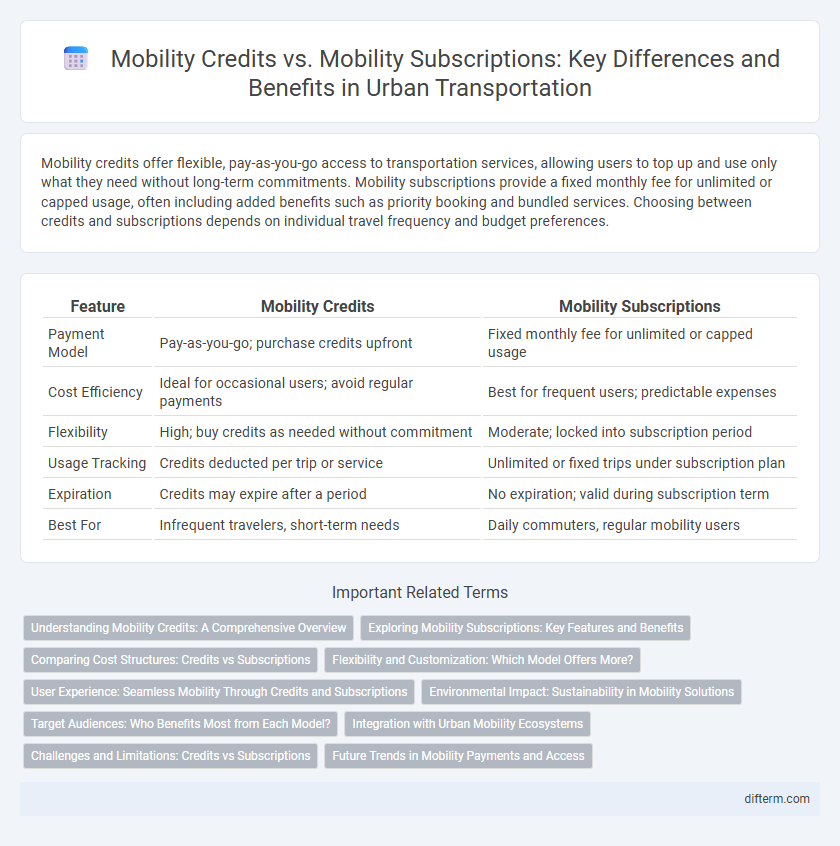Mobility credits offer flexible, pay-as-you-go access to transportation services, allowing users to top up and use only what they need without long-term commitments. Mobility subscriptions provide a fixed monthly fee for unlimited or capped usage, often including added benefits such as priority booking and bundled services. Choosing between credits and subscriptions depends on individual travel frequency and budget preferences.
Table of Comparison
| Feature | Mobility Credits | Mobility Subscriptions |
|---|---|---|
| Payment Model | Pay-as-you-go; purchase credits upfront | Fixed monthly fee for unlimited or capped usage |
| Cost Efficiency | Ideal for occasional users; avoid regular payments | Best for frequent users; predictable expenses |
| Flexibility | High; buy credits as needed without commitment | Moderate; locked into subscription period |
| Usage Tracking | Credits deducted per trip or service | Unlimited or fixed trips under subscription plan |
| Expiration | Credits may expire after a period | No expiration; valid during subscription term |
| Best For | Infrequent travelers, short-term needs | Daily commuters, regular mobility users |
Understanding Mobility Credits: A Comprehensive Overview
Mobility credits offer users a flexible, pay-as-you-go option for transportation, allowing them to purchase credits that can be redeemed across various mobility services such as bikes, scooters, and car-sharing platforms. Unlike traditional mobility subscriptions that require a fixed monthly fee and often limit usage to specific vehicle types or services, mobility credits provide greater adaptability by enabling users to manage their spending according to actual travel needs. Understanding the benefits and limitations of mobility credits is crucial for optimizing cost-efficiency and convenience in urban transportation planning.
Exploring Mobility Subscriptions: Key Features and Benefits
Mobility subscriptions offer users flexible, all-inclusive access to various transport modes, eliminating the need for individual ride purchases typically associated with mobility credits. Key features include unlimited travel within defined zones, multi-modal integration, and cost predictability, enhancing urban mobility efficiency. Benefits encompass simplified budgeting, seamless travel experiences, and promoting sustainable transportation choices through increased public transit and shared mobility usage.
Comparing Cost Structures: Credits vs Subscriptions
Mobility credits offer pay-as-you-go pricing, allowing users to pay only for the actual usage without fixed monthly fees, which suits occasional travelers or unpredictable schedules. Mobility subscriptions typically involve a fixed monthly fee, providing unlimited or discounted access to multiple transport modes, ideal for frequent commuters seeking cost predictability. Evaluating cost efficiency depends on travel frequency, distance, and mode preference, with credits benefiting low usage and subscriptions favoring consistent daily mobility.
Flexibility and Customization: Which Model Offers More?
Mobility credits offer greater flexibility by allowing users to pay only for the exact distance or time they travel, enabling customized usage based on individual needs. Mobility subscriptions provide fixed access to a range of transportation options for a set period, which can be cost-effective but less adaptable to varying travel patterns. Users seeking highly personalized mobility solutions often benefit more from credits, while those valuing predictability may prefer subscriptions.
User Experience: Seamless Mobility Through Credits and Subscriptions
Mobility credits offer users flexible access to diverse transport modes without long-term commitments, enhancing on-demand convenience and budget control. Mobility subscriptions provide consistent, predictable access to vehicles or services, fostering reliability and streamlined planning for frequent travelers. Combining credits and subscriptions creates a seamless mobility ecosystem that adapts to varying user preferences and optimizes overall travel experience.
Environmental Impact: Sustainability in Mobility Solutions
Mobility credits offer a flexible, usage-based approach that incentivizes reduced travel frequency, lowering overall carbon emissions compared to fixed mobility subscriptions that often lead to overuse and unnecessary resource consumption. By promoting shared, efficient vehicle access, mobility credits contribute to decreased urban congestion and a smaller environmental footprint. Choosing mobility credits aligns sustainability goals with user behavior, supporting greener, more responsible urban transportation systems.
Target Audiences: Who Benefits Most from Each Model?
Mobility credits suit occasional travelers and tourists seeking flexible, pay-as-you-go access to multiple transport modes without long-term commitments. Mobility subscriptions attract daily commuters and urban residents who value predictable costs and unlimited use within defined service areas. Businesses with employee mobility programs benefit from subscriptions by offering consistent access, while infrequent users prefer credits to avoid unused expenses.
Integration with Urban Mobility Ecosystems
Mobility credits offer flexible, pay-as-you-go access to a range of transport modes, enabling seamless integration with urban mobility ecosystems by adapting to user demand and reducing reliance on single-entity subscriptions. Mobility subscriptions provide predictable, fixed-cost access to specific transport services, supporting urban planners with steady demand forecasts but potentially limiting cross-modal integration. Effective integration in smart cities combines mobility credits' adaptability with subscriptions' stability to optimize multimodal transportation networks and enhance urban mobility efficiency.
Challenges and Limitations: Credits vs Subscriptions
Mobility credits face challenges in predicting user demand, leading to potential underutilization or depletion, whereas subscriptions offer predictable revenue but can result in inflexible user commitment and limited vehicle access. Credits require complex management systems to track and balance usage, posing scalability issues for providers. Subscriptions may not cater to occasional users, limiting market reach and reducing appeal for diverse mobility needs.
Future Trends in Mobility Payments and Access
Mobility credits offer flexible, pay-as-you-go options that appeal to users seeking cost-efficient, on-demand transportation without long-term commitments. Mobility subscriptions provide predictable expenses and seamless access across multiple transportation modes, enhancing user convenience and loyalty. Future trends indicate a hybrid model integrating credits and subscriptions with blockchain and AI-driven platforms to optimize payments, personalizing access based on user behavior and sustainability goals.
Mobility credits vs Mobility subscriptions Infographic

 difterm.com
difterm.com